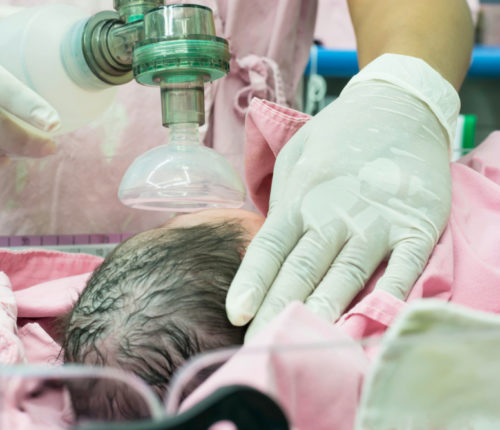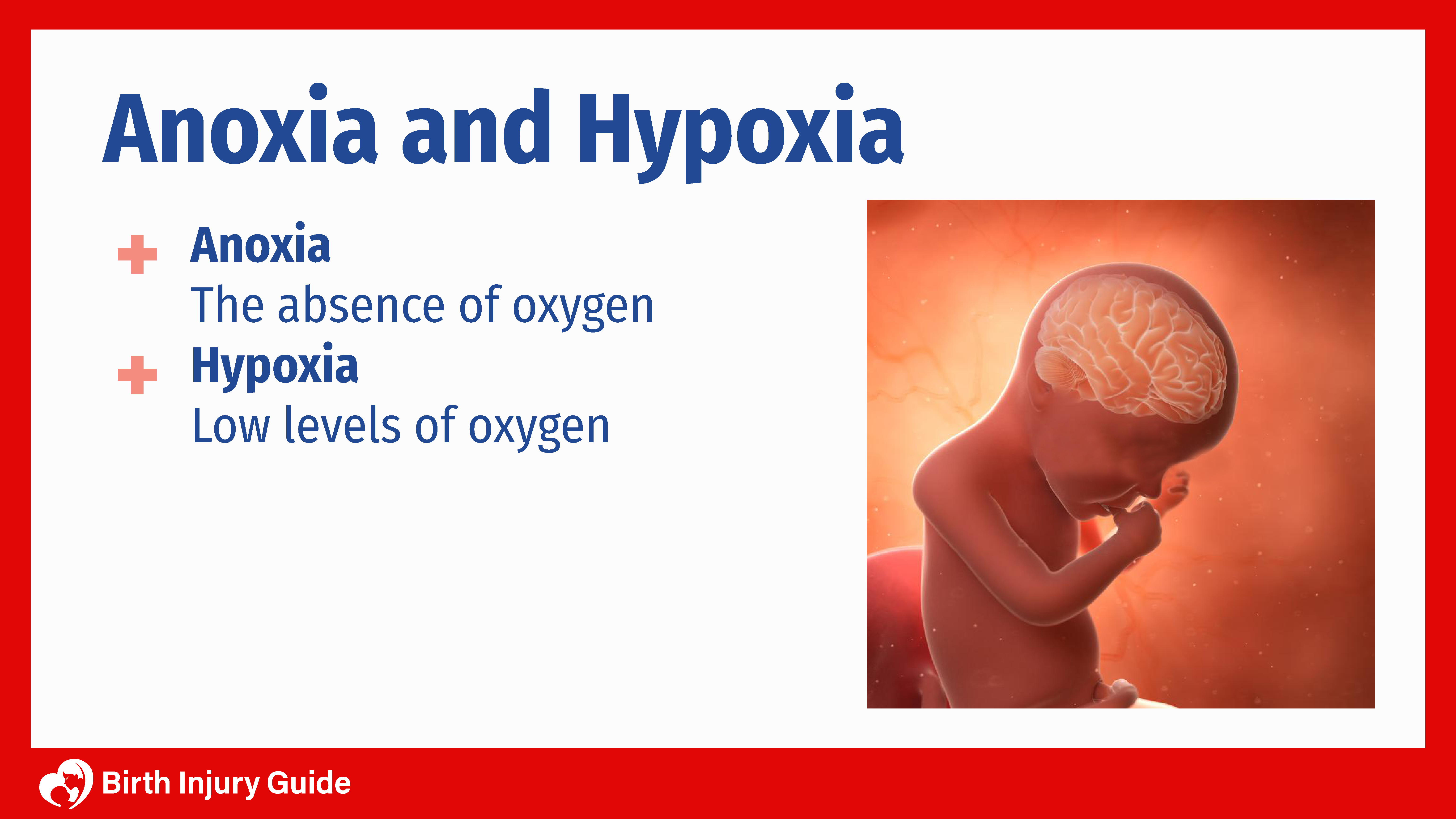
Anoxia and Hypoxia at Birth
Birth injuries occur for many reasons and can result in a variety of outcomes for the infant and his or her family. One of the primary causes for birth injuries is anoxia and hypoxia at birth. Anoxia and hypoxia are among the most dangerous and life-affecting causes of birth injuries. Anoxia refers to a complete lack of oxygen reaching important organs and tissues in the body. Hypoxia refers to a lack of oxygen.
Any type of oxygen deprivation around the time of birth can be devastating to the baby’s health. Oxygen deprivation can lead to hypoxic ischemic encephalopathy (HIE), which can cause brain damage and conditions like cerebral palsy. In the worst cases, it can be fatal.

What is Anoxia?
Anoxia is known as the absence of oxygen. Anoxia could be an environmental term, describing an environment that has no oxygen, such as anoxic waters or in space. Medically, anoxia describes the absence of oxygen with an emphasis on organs, muscle groups, or blood not getting sufficient oxygen. Cerebral anoxia is a term that describes when the brain is completely deprived of oxygen, a severe condition that often results in permanent brain damage. The opposite condition is called hyperoxia, when there is too much oxygen in the system.
What is Hypoxia?
Just as anoxia describes an absence of oxygen, so hypoxia describes low oxygen levels. Hypoxia is used to describe environmental areas. It is also used to describe low oxygen levels medically. Sometimes only one part of the body has a decrease in oxygen levels, such as one limb.
In infants, hypoxia can be a consequence of having a baby born pre-term, as the lungs aren’t developed enough for the baby to manage breathing on his or her own. Hypoxia may also be the result of a brain injury. Many infants who suffer anoxia/hypoxia develop a condition known as hypoxic ischemic encephalopathy (HIE), which is when blood flow is reduced or the level of oxygen in the blood is too low.
What Causes Anoxia and Hypoxia at Birth?
Anoxia and hypoxia are not a common hazard of childbirth. Sometimes during delivery, the umbilical cord can be pinched or kinked, causing the baby to be deprived of oxygen from the placental blood supply. The length of time the baby has reduced oxygen determines the depreciated levels of oxygen, so if the problem occurs for only a minute or so the baby may have hypoxia, whereas a baby that has prolonged lack of oxygen is more likely to have anoxia.
There are several risk factors and potential pregnancy complications that can lead to a lack of oxygen at birth, such as:
- Abnormal fetal presentation
- Cephalopelvic disproportion (CPD)
- Forceps delivery injury
- Vacuum extraction injury
- Resuscitation errors
- Placental abruption
- Prolonged labor
- Oligohydramnios (low levels of amniotic fluid)
- Umbilical cord prolapse
- Umbilical cord compression near baby
Women who have “high risk” pregnancies should be especially careful to monitor their health throughout the pregnancy. Women should attend all prenatal visits and should communicate with their doctors regularly if they have symptoms of complications.
There are also some well known maternal factors that increase the risk of oxygen deprivation at birth, such as:
- Preeclampsia
- Maternal obesity
- Gestational diabetes
- Maternal infections
- Advanced maternal age
Anoxia and Hypoxia and Medical Negligence
Healthcare providers must be diligent in monitoring the health of a mother and baby during pregnancy, labor and delivery. If doctors recognize fetal distress and act quickly, they may be able to avoid serious complications like anoxia and hypoxia at birth. If the doctor does not recognize fetal distress or does not take action in a timely manner, then they may held liable for any injuries the baby suffers. There are medical standards that doctors must follow when diagnosing and treating patients. When they do not follow those standards and a patient is harmed, they can be held liable for injuries and any resulting costs.
Some unfavorable outcomes during labor and delivery are due to unforeseeable circumstances outside anyone’s control. However, a sad reality is that many other birth injuries are caused by medical negligence. Doctors must be diligent in their diagnosis, treatment and management of medical conditions. They must administer treatment and medications in an appropriate way. And they must communicate appropriately with patients about what is happening and what to expect.
Start Your FREE Case Review Today
If you or your child is injured as a result of medical negligence, call us to learn more.
Symptoms of Anoxia and Hypoxia
The primary symptom of anoxia or hypoxia is the infant not breathing, or not breathing normally. When the brain has been deprived of oxygen for a certain amount of time, the brain goes into emergency mode and starts operating at a rapid speed until it starts malfunctioning. This can also lead to symptoms like seizures.
Sometimes, however, parents don’t realize that their child has suffered an anoxic or hypoxic brain injury until months or years later. Often, the first symptoms of a possible brain injury are missed developmental milestones or other cognitive difficulties.
Some of the symptoms that parents should be aware of include:
- Balance issues
- Movement disorders
- Developmental delays
- Visual problems
- Difficulties with speech
- Memory loss
due to an overload of electric signals. Generally, any period of not breathing is potentially dangerous to the brain, and if the child has stopped breathing for any longer than 6 minutes, severe damage can occur.
How Anoxia or Hypoxia Affects Children
Anoxia and hypoxia can both lead to brain damage in babies due to lack of oxygen, which can have a lasting, or even permanent, impact on your child’s life and wellbeing. Oxygen deprivation that results in a brain injury can lead to permanent disabilities, such as:
- Cerebral palsy
- Epilepsy
- Developmental issues
- Hearing impairment
- Vision impairment
Children who have disorders like these often require lifelong care and medical treatment, therapies and medications. Conditions like cerebral palsy may also require surgery to help manage symptoms. Some children require around-the-clock care and home modifications. All of these factors are expensive and have a profound impact on the entire family.
Tests to Confirm Anoxia or Hypoxia
There are a number of tests that can confirm an anoxic or hypoxic brain injury. These tests include a Head CT scan, an MRI, and an Electroencephalogram (EEG). Other more thorough tests include the SPECT tests, a form of CT scan that checks areas of the brain for blood flow and metabolism, and evoked potential tests, tests that evaluate the visual, auditory and sensory pathways.
Treatment of Anoxia and Hypoxia
One of the most common treatments for anoxia and/or hypoxia is therapeutic neonatal hypothermia, or cooling therapy. When applied appropriately, cooling therapy and slow down the brain, which also slows down brain damage. This allows the brain cells to recover over time. It also prevents additional cells from suffering damage and causing more permanent brain damage.
If your doctor sees that the child stopped breathing for anywhere up to 5 minutes, your doctor can prevent or substantially lessen the effects of the brain damage by putting the child on a ventilator.
Anoxia and Hypoxia Prognosis
Children who experience anoxia or hypoxia may have brain damage that impacts their health. The prognosis for a child with an anoxic or hypoxic brain injury will depend on the severity of the damage and his or her overall health, including the presence of other medical conditions. Babies that suffer hypoxic ischemic encephalopathy (HIE) may have more severe or permanent brain damage and are more likely to develop conditions like cerebral palsy.
Children who develop cerebral palsy or other long-term disorders will require extensive care. That care may include long-term or lifelong medications, therapies, special education, and round-the-clock care and supervision. It may also require surgery. For parents, this can be overwhelming. The good news is that with timely diagnosis and treatment, children with anoxia or hypoxia can go on to have a healthy and full life.



